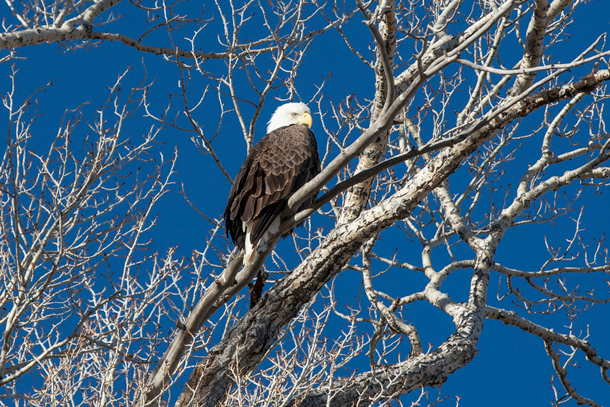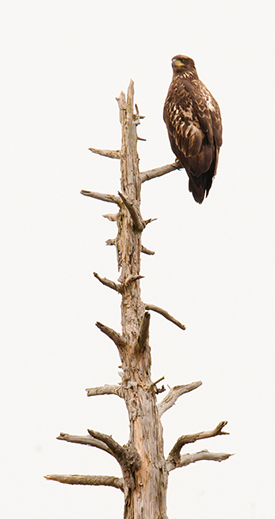Bald Eagles At Play
Air Date: Week of April 13, 2018

Two juvenile bald eagles fly close and lock talons. (Photo: Mark Seth Lender)
Connecticut River ecosystems have been impoverished over centuries by logging and overfishing, but now American Bald Eagles are returning. Living on Earth’s Explorer-in-Residence Mark Seth Lender watches young eagles on the river as they lock talons and fly playfully and finds them compelling.
Transcript
CURWOOD: The Bald Eagle is America’s symbol, a mighty, majestic bird that was nevertheless hunted and reviled by farmers who blamed it for killing livestock. Hunters, along with the pesticide DDT, proved all too successful, reducing the population in the Lower 48 states to barely 400 pairs by the 1950s.Their numbers have recovered since though, and now eagles can often be seen in comparatively suburban settings. But as Living on Earth’s Explorer-in-Residence Mark Seth Lender observed, wherever you see them they’re compelling.

An adult bald eagle looks out from his perch with a steely gaze. (Photo: Mark Seth Lender)
LENDER: Under clouds like a lead yoke, sun rises over sea smoke, painting color on the sky. Up the river over ice floes, at the bloom of the dawn rose, bald eagles rub their eyes. In their cold perches on dead branches of the riverside hemlocks, in the red raw hour as day flowers they are hardly, alive.
Not a clawed foot reaches.
Not a wing stretches.
Not a sparrow, flies.

A juvenile bald eagle perched high in a dead tree. (Photo: Mark Seth Lender)
This was a rich place once. Salmon and shad and menhaden traveling that fateful underwater road built on the ebb and flow of the tide. Up where the coves creep down and the river narrows, from salt to sweet over falls and shallows mortal fishes spawned and died. While the Atlantic sturgeon sowed his seed, and watched the centuries unwind.
Giant oak and tall pine lined the galleries and held the banks. We felled them for our tall ships. We carved the islands like carcasses to ballast those ships in gray granite blocks like tomb stones. We reaped the fish with mile-wide nets (billowing shadows of the Shadow of Death) and when there was almost nothing left, the last of the scales and gills and bones we ground to dust to feed our corn rows planted in unfertile ground.
But the young eagles know none of this. Care for none of this. Two fathom wide of wing spread between them, young Princes of status and of privilege, they prance upon the sands of 8 Mile Bar. The mates that they will find await them. The nests they will build in the trees that remain will caress the eggs they will guard. The young they themselves will feed on the fish such as they can find...
Determined and speeding, against all odds and dangers, they will lock talons, and rise again gleaming, Kings of the Air! And have a future. Such as we might leave them: to live, upon the gleanings.
CURWOOD: Mark Seth Lender is Living on Earth’s Explorer-In-Residence.
Links
Special thanks this week to Connecticut River Expeditions and the boat Riverquest
Living on Earth wants to hear from you!
Living on Earth
62 Calef Highway, Suite 212
Lee, NH 03861
Telephone: 617-287-4121
E-mail: comments@loe.org
Newsletter [Click here]
Donate to Living on Earth!
Living on Earth is an independent media program and relies entirely on contributions from listeners and institutions supporting public service. Please donate now to preserve an independent environmental voice.
NewsletterLiving on Earth offers a weekly delivery of the show's rundown to your mailbox. Sign up for our newsletter today!
 Sailors For The Sea: Be the change you want to sea.
Sailors For The Sea: Be the change you want to sea.
 The Grantham Foundation for the Protection of the Environment: Committed to protecting and improving the health of the global environment.
The Grantham Foundation for the Protection of the Environment: Committed to protecting and improving the health of the global environment.
 Contribute to Living on Earth and receive, as our gift to you, an archival print of one of Mark Seth Lender's extraordinary wildlife photographs. Follow the link to see Mark's current collection of photographs.
Contribute to Living on Earth and receive, as our gift to you, an archival print of one of Mark Seth Lender's extraordinary wildlife photographs. Follow the link to see Mark's current collection of photographs.
 Buy a signed copy of Mark Seth Lender's book Smeagull the Seagull & support Living on Earth
Buy a signed copy of Mark Seth Lender's book Smeagull the Seagull & support Living on Earth

